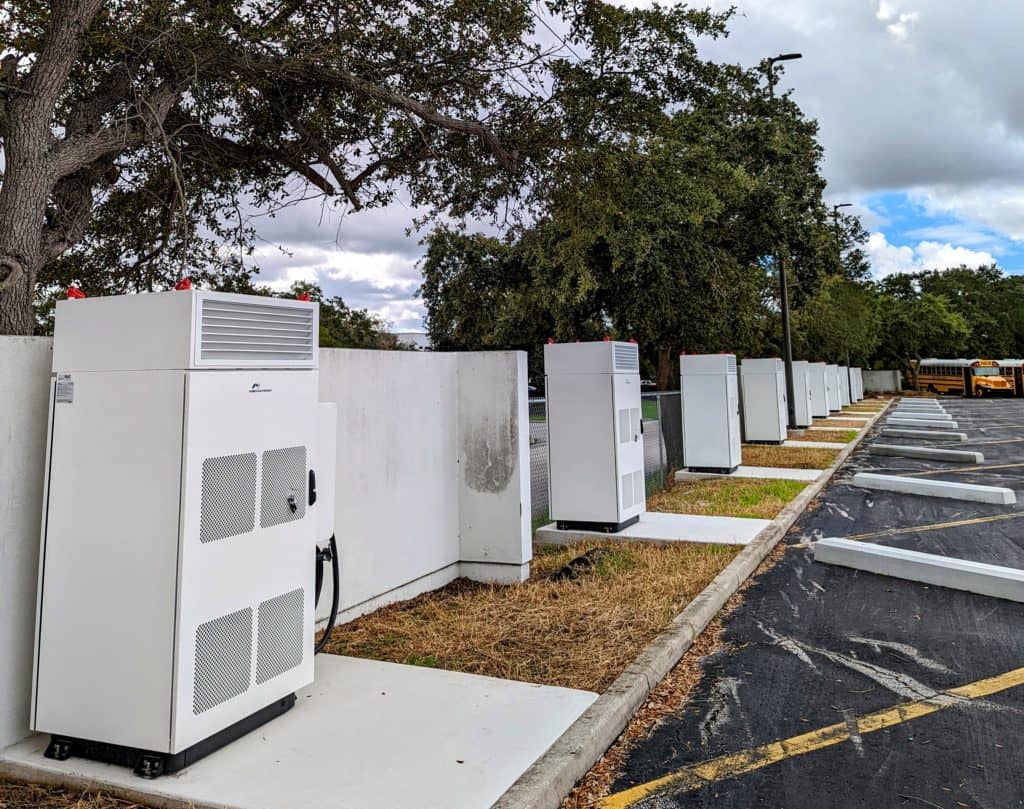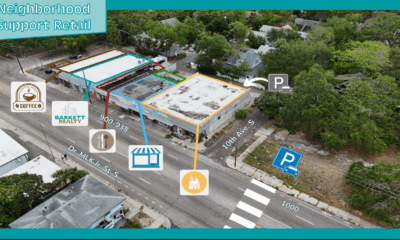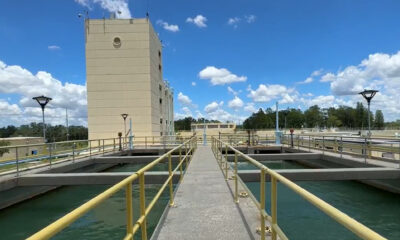Pinellas prepares for electric school buses

Thanks to a $5.5 million grant, the Pinellas County School District (PCS) will soon become one of the first in the state to swap out old diesel buses for new electric models.
While 20 environmentally friendly and quieter buses arrive in December, one of the district’s bus yards – the expansive Walter Pownall Services Center – recently installed 20 electric charging stations. PCS is purchasing the new vehicles with grant funding from a 2016 settlement between Volkswagen and the Department of Justice over the vehicle manufacturer’s emissions violations.
Head Technician Brian Lowe called it an exciting time for the school district as it continues utilizing new technologies. PCS now operates 188 propane-powered buses and will become one of the first in the state to put electric models on the road.
“We’ve done propane buses to help reduce emissions – now we’re doing electric and going for zero emissions,” said Lowe. “We’re trying to do our part to help the students and residents of Pinellas County, and the environment, by lowering our emissions.”
After about a year-long process, the district gained approval for the grant in the spring. It began installing the charging stations at the end of July through a partnership with Duke Energy Florida. Lowe expects to save money on diesel fuel and maintenance – such as oil changes – but said it is hard to compare operational costs as PCS is entering a new era.

The expansive Walter Pownall Services Center is now home to 20 of charging stations, which can fully charge a bus in two to three hours.
Broward, Manatee, Miami-Dade, Orange, Palm Beach and Sarasota Counties are also receiving grant money from the Volkswagen settlement to add electric buses to their fleets.
“Nobody in the state has them yet,” said Lowe. “So it’s hard to say what the difference in cost to charge a bus versus fuel is.”
However, Lowe is sure that lower emissions are better for students, drivers and county residents. He also noted that electric motors run much quieter than diesel engines.
Lowe said he was able to test drive buses from three manufacturers and the noise reduction was significant, calling that his “biggest takeaway.” Operational controls will remain the same, added Lowe, aside from the regenerative braking system in electric vehicles. That mechanism captures kinetic energy from braking and converts it into electrical power.
Although district officials have yet to decide on a manufacturer, Lowe said that any company they choose would provide initial and periodic training for drivers and maintenance staff. He also noted that a bumper-to-bumper manufacturer’s warranty would cover part replacement costs for seven years.
“So, we’ll be leaning on the manufacturer or the dealers,” said Lowe. “Until we get enough training to be certified mechanics, none of them want you messing with the electric drive system.”
PCS, he explained, operates 333 buses daily. The oldest models date back to 2003, and those will be the first to go when the electric ones arrive.

PCS also operates 188 propane-powered buses.
The electric buses cost about $400,000, nearly quadruple what the district would pay for a diesel model. However, the grant covers 75% of the price, which means PCS will pay what it would for a typical bus.
“So, out of pocket for the district, there’s no additional expenditure because of this grant,” said Lowe.
He said the grant comes with strict stipulations meant to reduce emissions. The district must take the oldest buses off the road first, he explained, before destroying them.
Lowe said his staff must cut the old buses into pieces and drill a three-inch hole in the engine block. Once that work is complete, it is off to the scrap yard. He said that is to ensure the buses are not resold and end up back on the road – due to the emission reduction component of the grant.
While PCS officials are still ironing out program details, Lowe believes they will assign the electric buses to specific routes. The procedure for the typical models, he explained, is that drivers bid on routes and buses according to seniority at the beginning of the school year.
Lowerelayed that according to the manufacturer, the 80 kW DC fast charging stations can charge a bus from 20% to 100% in less than three hours. According to PCS statistics, drivers typically log between 150 to 180 miles a day.
“So, the bus can do its morning route, come back, plug in and be fully charged for the afternoon route,” he added.
PCS officials expect to put the new electric school bus on the road in January, or February at the latest.








Dave Feddon
September 15, 2022at3:51 pm
two issues with the article, the vehicles themselves may be zero emissions, however, the following is copied from another article on this same email.
“Duke Energy Florida’s St. Petersburg headquarters.
Gibbs explained that while the company does not provide natural gas to homes, the utility uses it as fuel for its power plants. She said the company continues to diversify its fuel mix, with an increasing number of solar stations and two coal units in Crystal River.
Duke Florida began investing heavily in solar power in 2018, and Gibbs said that by 2024, the company would dedicate $2 billion to produce nearly 1,500 megawatts of renewable energy from 20 solar plants. However, as those stations rely on sunlight, she noted the importance of utilizing natural gas to offset overnight production and cloudy days.”
Electric companies are using 3 times amounts of fossil fuels to create electricity and route to charging stations for these zero emission vehicles.
Also note that the grant is requiring the destruction of the buses, if you follow history, this is what the oil and tire industries did when the sold governments on switching from electric trollies to buses. all the pluses of the switch were spread the media and the cons were hidden and silenced.
The article talks about the cost of the electric buses being $400k but the grant reduces it back to the $100k that would be spent on a replacement diesel bus, but what about the cost of the charging stations, the cost to upgrade the electric to serve them, the cost to extend the power to them, the training of techs to work on them, new technology to work on them.
I am not against moving to renewable resources or new technology but state all of the facts, including this electrification of the Country that the current electrical grid can not support, is being financed by one utility the disruption and blocking of competing utility that they themselves are using.
Donna Kostreva
September 15, 2022at3:37 pm
Electric vehicles are charged using FOSSIL FUELS, thus defeating the original “green “ premise. Communist China owns the mining rights to the rare earth minerals in most of Africa, China and S. America. The mining itself is very destructive to the environment. It would be far better to make demands on communist China to stop their exhorbitant carbon emissions.